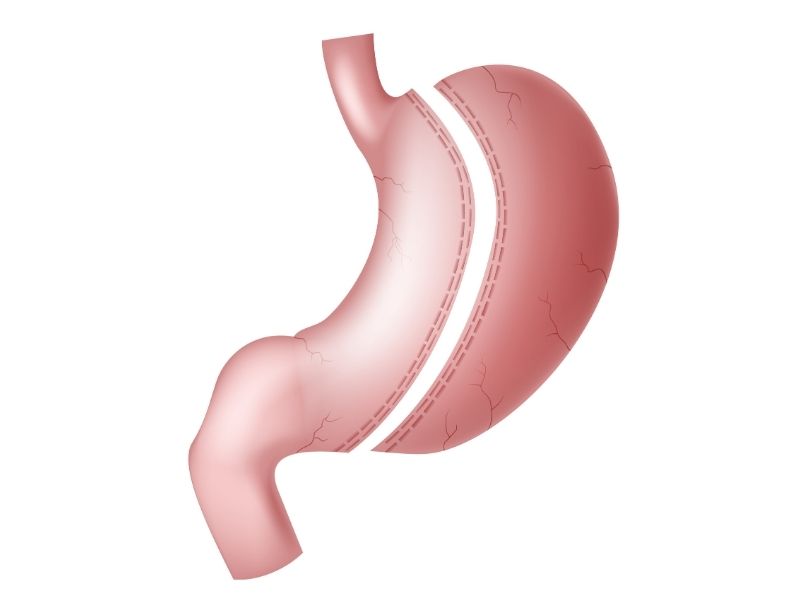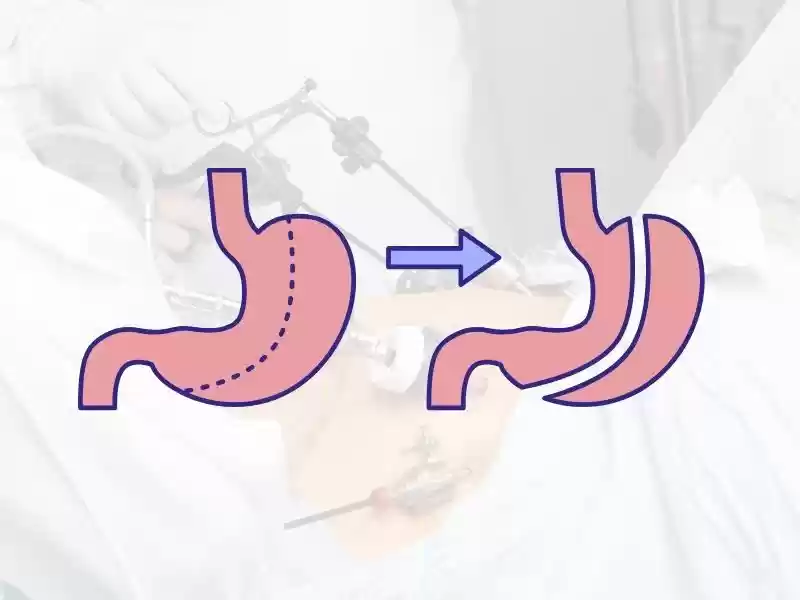Gastric sleeve gastrectomy is a method used in the treatment of obesity in which most of the stomach is cut, leaving a tubular stomach. With gastric sleeve surgery, weight loss is achieved over a long period of time. It can be called the most effective treatment against obesity. While obesity is treated with sleeve gastrectomy surgery, other health problems related to obesity also improve.
How is Sleeve Gastrectomy Surgery Performed?
Sleeve Gastrectomy, also called sleeve gastrectomy, is a surgical operation for weight loss. It is one of the most common obesity surgery procedures. The operation generally provides weight loss by reducing the volume of the stomach, restricting the food intake and consequently reducing calorie intake. Laparoscopically (closed), an incision and suturing process is applied starting from the antrum of the stomach and extending along the stapler line that ends at the proximal his angle. Approximately 80% of the stomach (depending on its size) is removed. Since there is no dome part of the stomach remaining after the operation, it is likened to a tube and for this reason, although it is called sleeve gastrectomy in medicine, it is popularly referred to as Tube Stomach Operation.
What are the Risks of Sleeve Gastrectomy?
The risks of sleeve gastrectomy surgery generally include the complications of a surgery and the risks created by the sleeve gastrectomy itself. In general, surgical procedures have risks such as bleeding, infection, anesthesia-related problems. The risks of gastric sleeve surgery can be listed as follows.
If the patient is not careful after sleeve gastrectomy, the stomach may expand.
As the stomach expands, the patient may gain weight again.
Leakage in the stomach is an unsettling risk.
Bleeding in the stomach or bleeding in the abdomen may occur.
Problems such as vomiting, nausea and abdominal swelling can be seen during the adaptation process of the stomach.
Who Can Get Gastric Sleeve Gastrectomy?
Those with a Body Mass Index (BMI) of 40 and above (morbid obesity),
Those with a Body Mass Index (BMI) between 35-40 and have a health problem such as obesity-related diabetes or sleep apnea,
It is suitable for obese patients with a Body Mass Index (BMI) between 30-35 who have serious health problems due to obesity and whose living standards are affected due to their excess weight.
Even for patients who meet the above criteria, the type and necessity of the operation is decided together with the patient in line with the recommendations of the surgeon who will perform the operation.


In the postoperative period, adequate energy and nutrient intake is important to support weight loss and tissue healing. In addition, the foods consumed should support weight loss while minimizing the occurrence of reflux, heartburn, nausea, early feeling of satiety and dumping syndrome that may occur after bariatric surgery.
Priority requirements in the nutrition of postoperative bariatric surgery patients include dietary phases (clear liquid, liquid, puree, soft and solid), protein intake, fluid requirements and vitamin mineral supplementation. A low sugar clear liquid diet can usually be started within 24 hours of any bariatric surgery procedure. However, the progress of this diet and nutrition procedure should be evaluated by the gastric sleeve doctor and dietitian. The protein requirement of the patient is individual and should be planned by the dietitian according to gender, height and age. It is recommended that the patient should take an average of 60-80 g protein or 1-1.5 g/kg protein during the day.
What are the Advantages and Disadvantages of Gastric Sleeve Gastrectomy?
The biggest advantage of sleeve gastrectomy is to feel full with a small amount of food. Since the hormone that gives the feeling of appetite will decrease, the appetite of the person will also decrease. A balanced diet and a little bit of everything can be eaten. Most of the excess weight is lost within a year. If the patient does not follow the rules regarding nutrition after surgery, there is a risk of the stomach growing back.
What is the Success Rate of Gastric Sleeve Gastrectomy?
Within the first year after sleeve gastrectomy surgery, almost most of the patient's excess weight is lost. In fact, how much attention the patient pays after the surgery is an important factor in the success of sleeve gastrectomy surgery. If the patient continues to overeat and expand his/her stomach, it means that he/she is not psychologically suitable for this process and the gastric sleeve surgery process cannot be successful. Mostly after the surgery, patients maintain the weight they lose in the first year for 10 years. In the following period, they continue their lives in a healthy way.
What is the weight loss process after sleeve gastrectomy?
The weight loss process after sleeve gastrectomy may be different for everyone. Factors such as diet, exercise, metabolism and psychological state of the patient after surgery affect the weight loss process. After bariatric surgery, the rate of weight loss varies depending on factors such as the initial weight of each patient, comorbidities and age that affect the metabolic rate.
However, patients are expected to lose approximately
10% of their initial weight in the first month,
10% of their initial weight between months 1-3
About 10% of their initial weight between 3-6 months
Between 6 months and 1 year, they are expected to lose 1o% of their initial weight and reach or approach their ideal weight.
For example, a patient who enters surgery with 100 kg,
-10 in 1 month
-10 between months 1-3
-10 between 3-6 months
Between 6th month and 1st year, he loses -10 kg and reaches 60 kg within 1 year.








